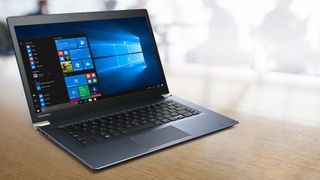Why you can trust TechRadar
Performance
The 2.7GHz Core i7-7500U processor makes this system wonderfully responsive, aptly demonstrating what a significant improvement Kaby Lake systems were over the Skylake designs that came before.
Here’s how the Toshiba Tecra X40-D-10H performed in our suite of benchmark tests:
Passmark: 2709
Passmark CPU: 5264
CPU-Z: 351 (single-thread); 1037 (multi-thread)
Geekbench: 4176 (single-core); 8066 (multi-core); 17640 (compute)
Cinebench: OpenGL: 38.6 fps; CPU: 349
CrystalDiskMark: 552 MBps (read); 514 MBps (write)
Novabench: 1020
Atto: 532 MBps (read, 256mb); 553 MBps (write, 256mb)
Sisoft Sandra (KPT): 6.73
UserBenchmark (higher is better): 46
PCMark 8 Battery (work test): 3 hrs 54 mins
The power is especially noticeably moving between multiple applications, where the Tecra delivers desktop PC levels of performance and doesn’t easily bog down with more challenging tasks.
While this isn’t a gaming system, Intel’s HD Graphics 620 is good enough to handle some 3D work if you’re prepared to balance the demands of detail and screen resolution.
For 2D graphics, the integrated GPU is sufficiently powerful to drive presentations and video streaming very cleanly, and for a long time, using relatively low levels of power.
Battery life is good, and the Type-C connections can recharge the battery rapidly if you get brief access to mains power.
Toshiba quotes a battery life of 10 hours 30 minutes via MobileMark 2014 testing, and our analysis achieved nearly 4 hours using the PCMark 8 Work benchmark.
Most working days aren’t as abusive as the PCMark 8 test, so the Tecra X40-H should be good for more than 8 hours of practical use, or even longer if you’re just browsing the web.

In use
There are many things about the design of this notebook that we adored, and relatively few elements that we didn’t care for.
One feature that we must applaud is the use of USB Type-C connectors, as both a charging mechanism and as a means to connect peripherals. Laptop makers need to move away from proprietary power connectors, and Type-C is one way to go.
By doing this they not only free themselves from having to stock many different PSU designs, but this also creates an extra USB port when the machine is not being recharged.
The full scope of how this technology enhances the Tecra is demonstrated well by Toshiba’s new Thunderbolt 3 Dock.

With that one accessory a single Type-C Thunderbolt downlink is redistributed into two HDMI ports, a DisplayPort, Mini DisplayPort, VGA connector, a headphone/microphone combo jack, four USB 3.0 Type-A ports, a pair of USB Type-C ports and a 10/100/1000 Ethernet connector.
In short, this is a highly useful accessory which anyone buying this machine in a business environment should budget to include with any X40-D deployment.
Other strong points include a solid display that has an anti-reflective coating and a decent native resolution of 1080p, along with an effective keyboard and an excellent touchpad.
Where this machine is less wonderful is the screen hinge, which looks like it should be reversible, but isn’t. And the lack of a PCIe SSD does limit drive performance to what SATA can offer.
Realistically, few people in the business world are going to moan about the lack of a LAN port, and of course you can always get this through the Thunderbolt 3 Dock.
The only other complaint we’ve got is that Toshiba, like many laptop makers, can’t resist marching across the Windows installation with its branded boots on.
Why manufacturers bother to do this is a mystery, because any machine controlled by an IT department will have all that junk stripped off long before the user gets anywhere near it.
Overall, the Toshiba Tecra X40-D-10H offers a great, if sanitized, notebook experience that demonstrates the skill of the product engineers that the company employs.

Final verdict
There are cheaper Ultrabooks that use this processor, but few are this well designed and thoughtfully balanced. The Tecra combines high performance levels with decent battery life and excellent connectivity options, and it’s an especially attractive package for business customers.
It might not have the reversible hinge of HP’s x360 models, but for those who want a laptop and not a tablet, the hardware inside is more than adequately provisioned.
The Toshiba Tecra X40-D proves that the best business hardware sticks to the brief rather than trying to attract attention with radical styling choices.
- We’ve picked out the best business laptops of 2017
Mark is an expert on 3D printers, drones and phones. He also covers storage, including SSDs, NAS drives and portable hard drives. He started writing in 1986 and has contributed to MicroMart, PC Format, 3D World, among others.


